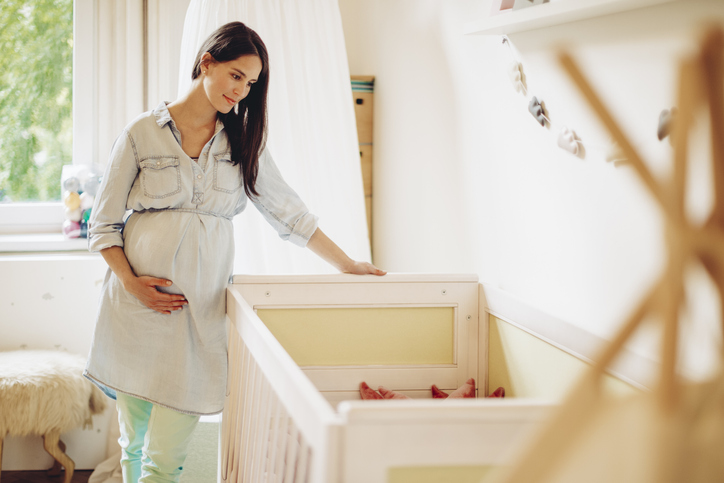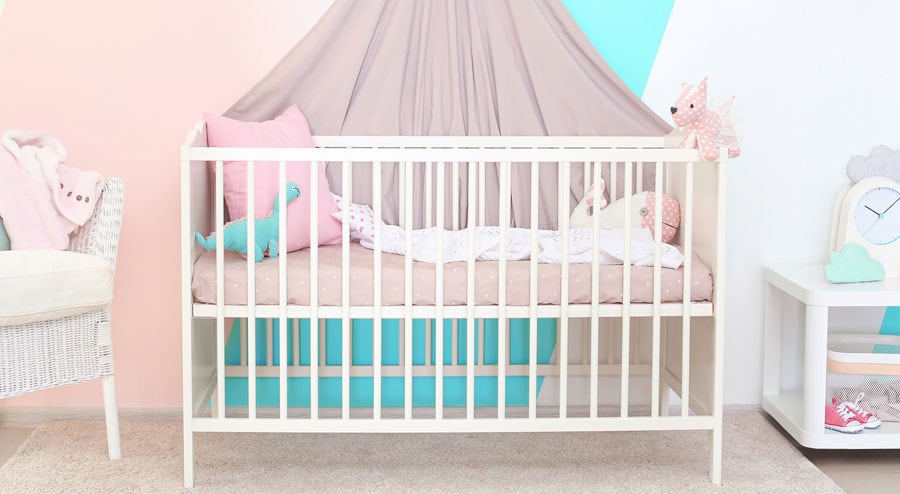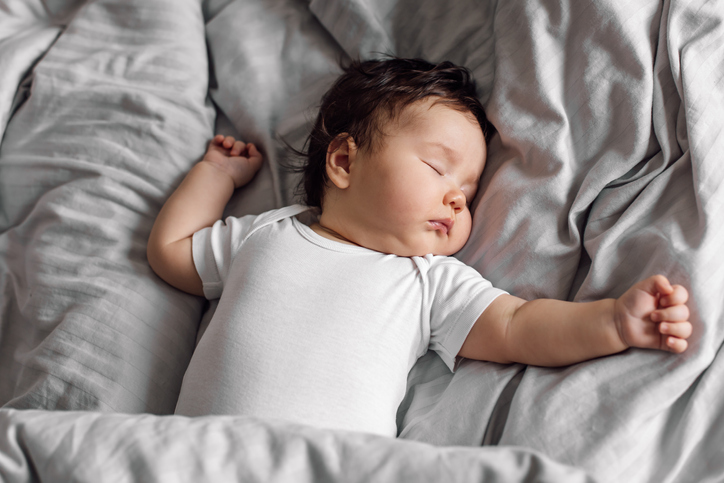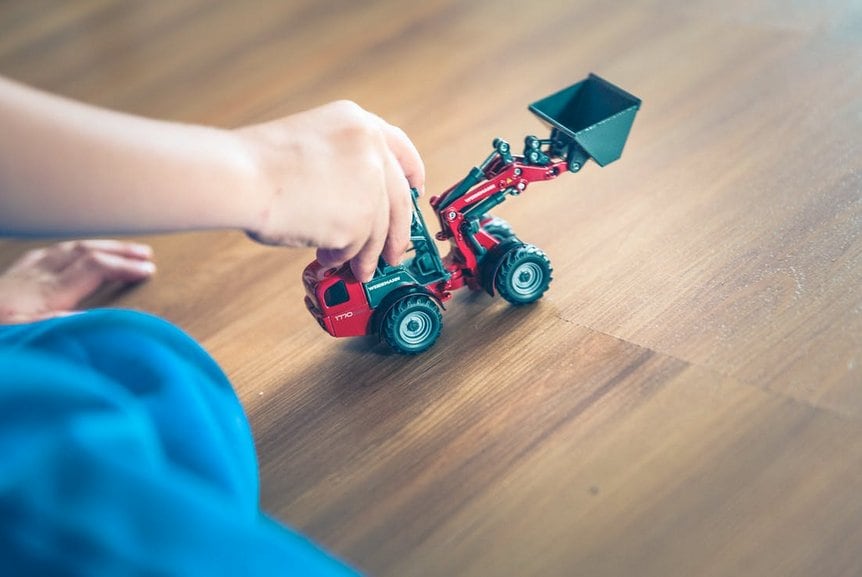Crib-related accidents can have serious consequences, underscoring the need for careful consideration in making this essential decision. One of the primary factors to consider is crib safety features. These include adjustable mattress heights to accommodate your growing baby, as well as slats that are appropriately spaced to prevent entrapment. Additionally, it is important to choose cribs made from safe and non-toxic materials to safeguard your baby’s health. Understanding the special needs and features of safe cribs is essential in maintaining a secure sleeping space for your child.

Table of Contents
- Understanding Crib Safety
- Key Safety Features to Look for
- Choosing Safe and Non-Toxic Materials
- Addressing Other Specific Safety Concerns
- Maintenance and Long-Term Use
- Ensuring Regional Safety Compliance
- Personalizing Safety for Special Needs
- Baby-Proofing the Crib Environment
- Transitioning to a Toddler Bed
- Take Away
Understanding Crib Safety
The safety of your baby’s sleeping space begins with a thorough understanding of crib safety regulations, standards, and certifications. These regulations are put in place to guarantee that cribs on the market meet specific safety criteria, providing parents with peace of mind. When choosing a crib, look for products that comply with recognized standards such as the Consumer Product Safety Commission (CPSC) guidelines in the United States, or equivalent regulatory bodies in other regions.
You should avoid using older or secondhand cribs, as they may not meet the latest safety requirements. Over time, safety standards have evolved, and newer cribs are designed with enhanced safety features to reduce the risk of accidents and injuries. Older models might lack crucial safety elements, such as the absence of drop-side functionality, which has been deemed hazardous due to its potential for malfunctioning and entrapment. Opting for a new, up-to-date crib ensures that your baby’s sleeping space is equipped with the latest safety advancements, offering a secure environment for peaceful sleep.
You should avoid using older or secondhand cribs, as they may not meet the latest safety requirements. Over time, safety standards have evolved, and newer cribs are designed with enhanced safety features to reduce the risk of accidents and injuries.
Key Safety Features to Look for
There are several essential safety features to prioritize when selecting a crib for your baby such as the space between the crib and the slats. Another feature to look for is an adjustable mattress height. This feature allows you to lower the mattress as your baby grows and becomes more mobile. Starting with the highest setting for easy access to the newborn, you can gradually lower it to prevent climbing or falling out as the baby becomes more active. This flexibility ensures that the crib remains a safe and comfortable environment throughout your baby’s developmental stages.
The spacing between the crib slats is a very important feature to consider. The recommended distance is no more than 2 3/8 inches (approximately 6 centimeters) to prevent the baby’s head from getting trapped between the slats. Properly spaced slats also prevent the risk of limbs becoming stuck, reducing the chances of injury. Paying attention to this feature significantly reduces the risk of potential hazards and ensures a safe sleeping space.
Many cribs also come equipped with teething rails. These protective covers are made of non-toxic materials and cover the top edges of the crib’s railings. As babies start teething, they often chew on the crib rails, and teething rails prevent them from ingesting harmful substances or damaging the crib. Investing in a crib with this feature adds an extra layer of protection and helps maintain the crib’s structural integrity over time.
Considering and understanding these key safety features allows parents to make an informed decision when choosing the right crib for their baby’s sleeping space.
Choosing Safe and Non-Toxic Materials
Choosing a crib made from safe and non-toxic materials such as solid, sustainable wood, from brands like Babyletto and Pottery Barn Kids offers cribs that meet the criteria for a safe sleeping environment. These materials are free from harmful chemicals and provide a sturdy foundation for the crib.
The choice of crib mattress is also important to consider. Brands like Naturepedic and Newton Baby offer organic crib mattresses made from natural, hypoallergenic materials, promoting better air circulation and preventing allergen accumulation. Choosing an organic crib mattress ensures your baby is not exposed to potentially harmful toxins or allergens during their sleep.
Avoiding finishes containing volatile organic compounds (VOCs) or lead-based paints. Cribs from reputable brands like Babyletto and Ubabub, certified with Greenguard Gold, meet stringent standards for low chemical emissions, promoting healthier indoor air quality for your baby’s nursery.
Carefully selecting cribs and accessories made from safe and non-toxic materials, allows for parents to create a healthier sleeping space for their baby, fostering a peaceful and secure environment for their sleep.
Addressing Other Specific Safety Concerns
Other specific safety concerns to address include crib bumpers for instance. These were traditionally used to prevent the baby from hitting their head against the crib’s hard sides. However, research and experts now advise against using crib bumpers, as they pose a suffocation and entanglement hazard. Instead, opt for a firm, well-fitted mattress and dress the crib with a tight-fitting crib sheet for a safe sleep environment.
Drop-side cribs should also be considered. While they were once a popular choice for their accessibility, drop-side cribs have been deemed unsafe due to the risk of malfunctioning and entrapment. Instead, choose a fixed-side crib from reputable brands like Delta Children or Graco, which meet the latest safety standards and provide a stable and secure sleep space for your baby.
Avoid items that could be choking hazards or pose risks of entanglement when choosing crib accessories. Instead of crib mobiles with strings or ribbons, select well-secured wall-mounted or ceiling-hung mobiles, like those offered by Tiny Love or Fisher-Price. Additionally, refrain from placing pillows, loose blankets, or stuffed animals inside the crib, as they may increase the risk of suffocation. Eliminating these potential hazards ensures a safe sleeping environment for your child.
Maintenance and Long-Term Use
For the long-term safety and durability of the crib, check and tighten all hardware and fasteners periodically to prevent any loosening, which could compromise the crib’s stability. Keeping the crib clean is also important – use a mild soap and water solution to wipe down the crib regularly, and avoid harsh chemicals that may damage the crib’s finish or pose health risks to your baby.
Convertible cribs are an excellent option for parents seeking a long-term solution. Brands like Storkcraft and Babyletto offer convertible cribs that transform from a standard crib to a toddler bed, daybed, or even a full-sized bed, adapting to your child’s changing needs. While convertible cribs may have a higher upfront cost, their versatility eliminates the need to purchase additional beds as your child grows. This cost-saving benefit, combined with their safety features, makes convertible cribs a popular and practical choice for many families.
Properly and regularly maintaining your chosen crib and considering the advantages of convertible models, creates a safe and functional sleeping space that grows with your baby throughout their early years.
Ensuring Regional Safety Compliance
To check if the crib complies with safety standards in your country or region, begin by checking for specific safety certifications or labels on the crib’s packaging or product description. In the United States, for example, look for cribs certified by the Consumer Product Safety Commission (CPSC) or those meeting ASTM International standards. In Europe, cribs complying with the EN 716 safety standard are recommended.
To further verify safety compliance, consult reputable sources such as the Juvenile Products Manufacturers Association (JPMA) or safety organizations in your country. They often maintain lists of approved crib models that meet the necessary safety requirements. Additionally, you can visit the website of your country’s consumer protection agency or product safety commission to access recalls and safety alerts related to the selected crib model. Staying informed about any potential issues can help you make an informed decision and prioritize your baby’s safety.
Personalizing Safety for Special Needs
For parents with babies who have special needs or medical conditions, consulting with their healthcare provider is crucial in determining the most suitable crib features and accessories. For babies with mobility or sensory challenges for instance, cribs with lower mattress heights can make it easier for them to access and exit the crib safely. Brands like DaVinci and Graco offer cribs with adjustable mattress heights, allowing parents to cater to their child’s unique needs as they grow and develop.
Parents may also need to consider specialized accessories, such as foam crib wedges for babies with reflux or positioning devices for infants with specific medical conditions. It’s important to research and select products that have been tested and recommended by medical professionals or have received appropriate safety certifications.
Furthermore, parents can explore cribs designed with extra safety features, such as additional slat reinforcement or secure locking mechanisms, to meet the specific needs of their baby. While these cribs may have higher costs, the added peace of mind and safety they offer for babies with special needs can be invaluable.
Ultimately, personalizing safety for babies with special needs involves thorough research, consultation with healthcare professionals, and choosing cribs and accessories that prioritize both comfort and safety for your child.
Baby-Proofing the Crib Environment
To baby-proof your child’s crib environment, begin by ensuring the crib is positioned away from windows, blinds, cords, and curtains to avoid any potential entanglement hazards. Moreover, keep the crib away from heaters, radiators, and direct sunlight, as these can pose risks of overheating or discomfort for the baby.
To prevent the baby from climbing out, remove any nearby furniture or objects that they could use as leverage to escape the crib. For additional security, consider installing crib rail protectors or covers, such as those offered by Trend Lab or Go Mama Go Designs, to prevent the baby from chewing on the crib rails or getting their limbs stuck between the slats.
As your baby grows and starts to stand, be sure to adjust the crib mattress to its lowest setting to prevent any attempts at climbing out. Brands like Dream On Me and Delta Children offer cribs with multiple mattress height options, providing flexibility as your baby reaches new developmental milestones.
Furthermore, dress the crib with a well-fitted crib sheet, avoiding any loose or excessive bedding, such as blankets, pillows, or crib bumpers, which can pose suffocation hazards. Opt for sleep sacks or wearable blankets from brands like Halo or Aden + Anais, which ensure your baby stays warm and secure without the risk of loose bedding.
Transitioning to a Toddler Bed
Signs that your child is ready to transition from a crib to a toddler bed is when they start attempting to climb out of the crib or when their height or weight exceeds the crib’s recommended limits. Climbing can pose safety risks, and if they have little room to move comfortably or are at risk of falling over the crib railings, it’s time to consider the transition.
When making the switch, choose a toddler bed with guardrails on both sides, like those offered by Delta Children or Dream On Me. These guardrails provide security and prevent the toddler from rolling out of bed during the night. It’s also a good idea to place the toddler bed in the same spot where the crib used to be, to create a sense of familiarity and comfort for your little one.
Involving your child in the process by letting them choose their new bedding or a favorite stuffed animal for their new bed can ease the transition. Keeping a consistent bedtime routine and offering praise and encouragement can also help your child feel more at ease with this change in environment.
The transition to a toddler bed can come with challenges but it is an important step in your child’s development. By paying attention to the signs of readiness and providing a secure and comforting sleeping space, you can make this transition a smooth and safe experience for your growing toddler.
Take Away
Choosing the right crib is crucial for your baby’s safety and well-being. Prioritize safety features like adjustable mattress height and appropriate slat spacing, while opting for non-toxic materials. Address specific concerns such as avoiding crib bumpers and drop-side cribs. Personalize safety for babies with special needs and ensure long-term safety and regional compliance. By prioritizing safety and taking advantage of resources, you can create a secure and comfortable sleeping space for your baby’s healthy growth and development.




